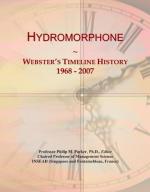|
This section contains 172 words (approx. 1 page at 300 words per page) |
Hydromorphone is a semisynthetic OPIOID analgesic (painkiller) derived from thebaine, an ALKALOID of the OPIUM poppy (PAPAVER SOMNIFERUM). It is one of the most widely used and effective analgesics for moderate to severe PAIN and is often referred to as Dilaudid, one of the brand names under which it is sold. Its potency is almost eightfold greater than is morphine's. Structurally, it is quite similar to MORPHINE but most like dihydromorphine, differing only in the replacement of the hydroxyl (-0H) group at the 6-position with a ketone (=0). Thus, it is not surprising that hydromorphone has many of the same side effects—including sedation, constipation, and depression of breathing. Chronic use will produce TOLERANCE AND PHYSICAL DEPENDENCE, much like morphine. This drug is reported to have high abuse potential, perhaps due, in part, to its very high potency.
 Figure 1 Hydromorphone
Figure 1 Hydromorphone
Bibliography
JAFFE, J. H., & MARTIN, W. R. (1990). Opioid analgesics and antagonists. In A. G. Gilman et al. (Eds.), Goodman and Gilman's the pharmacological basis of therapeutics, 8th ed. New York: Pergamon.
|
This section contains 172 words (approx. 1 page at 300 words per page) |


